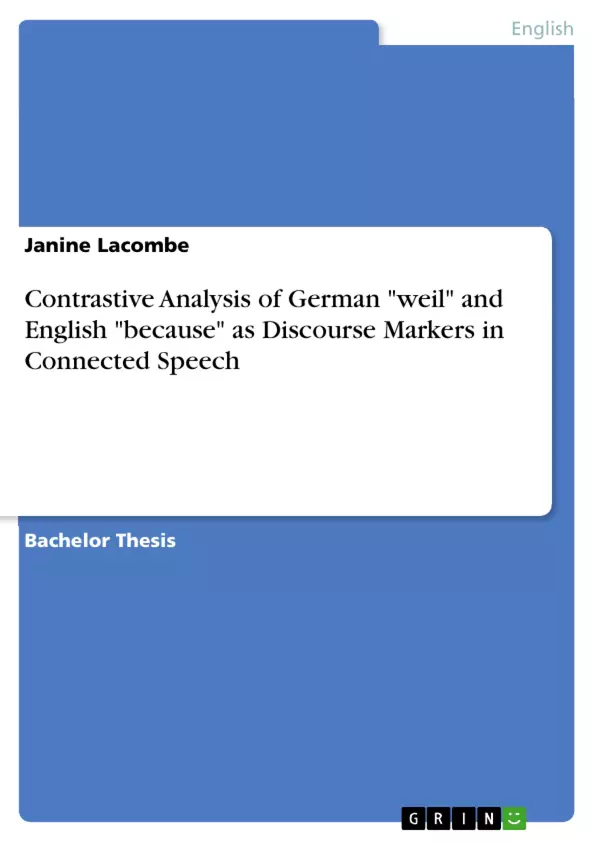Discourse markers mark discourse. Although this paraphrase may not be regarded incorrect, the subject proves to be far more intricate. Since verbal communication is regarded a highly structured social activity, connected speech as part of interactional spoken dialog requires a substantial amount of metalinguistic knowledge from all participants, speakers and hearers alike. When attempting to interpret possible speaker intentions, identifying word, phrase, and utterance borders as well as recognizing occurrences of speech repair and hesitation, the hearer relies on specific cues and signposts, respectively, assisting in structuring information distributed within discourse as well as organizing the alternation of speakership. Recent linguistic research has shown proactive interest in defining and categorizing such devices, including, inter alia, the rather controversial class of discourse markers.
The presented paper aims at investigating various uses and functions of German weil and English because as discourse markers in spoken discourse, also taking into account functional dissociations to other fields of operation.
Table of Contents
- Introduction
- General approach
- Primary objective
- Discourse markers
- Characteristic features
- Primary functions
- Contrastive analysis of English because and German weil
- weil
- Propositional versus non-propositional meaning
- Functions and examples of weil in corpus
- weil as a causal subordinating conjunction
- Epistemic weil
- weil referring to speech acts
- weil as discourse marker
- because
- Propositional versus non-propositional meaning
- Functions and examples of because in corpus
- because as a causal subordinating conjunction
- Paratactic uses of because
- because as discourse marker
- weil
- Results
- Bibliographic references
- Online sources
- Corpora
- Appendix
Objectives and Key Themes
This paper aims to investigate the diverse uses and functions of German "weil" and English "because" as discourse markers in spoken discourse. The analysis will explore both the similarities and contrasts between the two languages in their use of these discourse markers, while also examining their functional dissociations to other fields of operation. The analysis will be conducted through a contrastive approach, utilizing corpus data from the "Forschungs- und Lehrkorpus für gesprochenes Deutsch" (FOLK) and the "British National Corpus" (BNC).- Definition and categorization of discourse markers
- Contrastive analysis of "weil" and "because" as discourse markers
- Functional dissociations of "weil" and "because" to other fields of operation
- Discourse-pragmatic functions of "weil" and "because" in connected speech
- Similarities and contrasts between the use of "weil" and "because" in spoken discourse
Chapter Summaries
- Introduction: This chapter sets the stage for the investigation by discussing the complexities of spoken discourse and the role of discourse markers in aiding comprehension. It introduces the two languages of focus (German and English) and their respective discourse markers, "weil" and "because," outlining the general approach and primary objectives of the study.
- Discourse markers: This chapter delves into the complexities of defining "discourse markers" as a linguistic phenomenon, acknowledging the lack of a universally accepted definition due to the dynamic nature of language. It examines the diverse terminology used to describe these markers across different linguistic traditions, highlighting the challenges of finding common ground for contrastive analysis.
- Contrastive analysis of English because and German weil: This chapter presents a comparative analysis of "weil" and "because" in their propositional and non-propositional uses. It explores their different functions as causal subordinating conjunctions, discourse markers, and in other contexts, illustrating their usage with corpus examples from the FOLK and BNC.
Keywords
This study focuses on the contrastive analysis of German "weil" and English "because" as discourse markers in spoken discourse. The research explores the functional dissociations of these markers to other fields of operation, emphasizing their role in supporting hearer comprehension processes. Key concepts include discourse markers, spoken discourse, contrastive analysis, pragmatic functions, and corpus data.- Arbeit zitieren
- Janine Lacombe (Autor:in), 2012, Contrastive Analysis of German "weil" and English "because" as Discourse Markers in Connected Speech, München, GRIN Verlag, https://www.hausarbeiten.de/document/267181


